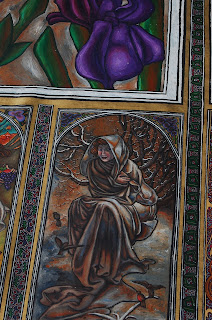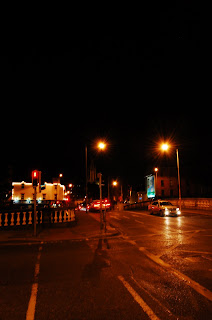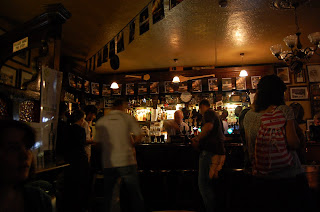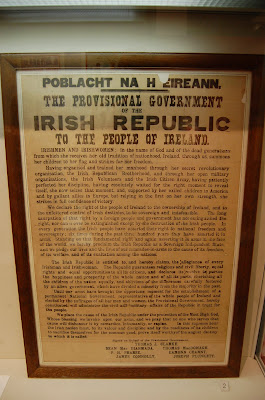Ireland's history has fascinated me for many years, and while I was there I could feel how important it was as an identification-marker. People were very aware of their history, of the great men and women that made a difference through hundreds of years, during both occupation and freedom. It's through the history they identify who they are, and it was so inspirational for a history-student from Norway to see a place where history really means something. A place were history is lived and not confined to dusty books in the very back of the library.
The last part of my stay was spent in the capital of the Emerald Isle; Dublin. A city steeped in history, where both rebels and poets found inspiration and acted on it. This is the city of saints and scholars, of culture beyond your wildest imagination and the most extreme political environment north of Cork and south of Malin Head.
And of course is everything connected; you cannot understand one thing without consider all the other factors too.
But let's not drown ourselves in all the problems. Let me begin my tale from Dublin...
Dublin is perhaps the place I've heard the most about the last few years, and it shouldn't come as any surprise that city is has a special place in my heart. I'm not a big fan of capitals (especially not my own; Oslo) because many of them are loosing their own identity when they meet the world; they are trying to be like everybody else. Please stick to what you can Dublin: BE IRISH!
Anyway, to just come to city I had heard so much about, was an experience for life. To see the place which is perhaps mentioned in more songs than any other place on the globe, the home and battleground for men like James Joyce, Padraig Pearse, Brendan Behan, Thomas Moore, Roger Casement, Sean O'Casey, Theobald Wolfe Tone, Bram Stoker and many more...They have all given this city a reputation and flavour that unlike many other international capitals still keep its contact with its past.
*Sorry if my word are incomprehensible...it is just that this city and my experience of it is difficult to describe in normal, neutral words. If you don't follow me, just ask me, please*
We arrived in the city on a fairly sunny Friday, and the walk from Busaras to Phibsborough took much longer time than planned because of two things:
1) No map
2) My suitcase had for some unknown reason gained weight in Donegal....
But we got there eventually, and it was a really nice place we would stay for the next 5 days.
 |
| Great place | |
|
Just as when I came to Derry, it took me some time to come to terms with the fact that i was actually IN Dublin. So every step I took, every sound I heard and all I saw was of great interest. I was like a newborn child, soaking it all up. The way back to the centre of the city; O'Connell Street, I tried to take notice of specific buildings that would help me remember the way (I have a really lousy sense of direction, so I had to keep my eyes wide open all the time).
So I counted churches....
This one was the closest to were we lived, and it was a truly amazing building. It feels like the building itself is growing into the skies, and I would soon understand that this rule counted for more than churches. Many buildings in this town is something more than just buildings, they are symbols of power and strength.
But Dublin is more than just a city of churches and big buildings. Its streets are also a source to some of the most horrifying and awe-inspiring stories ever told in the history of this nation.
When we passed this street, I asked Steven if he knew its significance in Irish history. Because something happened here in 1914... I came over this name in a song, and you know me: have to check everything up :p
Well, let me get to the story:
On July the 26th 1914 the Irish Volunteers landed some 900 German rifles and 29 000 rounds of ammunition on the Howth-peninsula north of Dublin, where they were met by members of the Irish Citizen Army, led by countess Markiewicz, ready to take the weapons to Dublin in wheelbarrows and hand carts.
At this point had the King's Own Scottish Borderers been informed of the situation, and sent out from the Kilmainham Barracks. They met them at Clontarf, but no weapons were seized because the Irish managed to keep the soldiers talking so long that they managed to hide the rifles.
But problems started in Bachelor's Walk were a large crowd had gathered and they were not pleased with seeing the KOSB's there.The soldiers were fairly frustrated, and at one point did they turn and started attacking the unarmed crowd, killing 3 and 32 were injured. As history would tell us, this wouldn't be the last time they did so...
I learned about this event through a song called "The Bachelor's Walk", and the first and the two last verses goes like this:
You true-born sons of Erin's Isle, come listen to my song,
My tale is one of sorrow but I won't detail you long,
Concerning the murderous outrage that took place in Dublin Town
When a cowardly regiment was let loose to shoot our people down.
On Bachelor's Walk a scene took place, which I'm sure had just been planned.
For the cowardly Scottish Borderers turned and fired without command.
With bayonets fixed they charged the crowd and left them in their gore,
But their deeds will be remembered in Irish hearts for evermore.
God rest the souls of those who sleep apart from earthly sin,
Including Mrs. Duffy, James Brennan and Patrick Quinn;
But we will yet avenge them and the time will surely come,
That we'll make the Scottish Borderers pay for the cowardly deeds they've done
 |
| A great man |
Dublin has indeed a glorious history, but wasn't just filled with rebels and poets. The man above, Jim Larkin, was an ordinary man that made extraordinary things happen. He may not have fought with a gun, or planned attacks on the "enemy" in the normal meaning of the word. His weapon was his tongue and fiery engagement for the workers of the city. He became a pillar in the growing labour-movement, and is most famous for his role in 'the Dublin-lockout' in 1913. The centre of dispute was about the Irish workers right to unionize, and the lockout lasted from 26th August 1913 to 18th January 1914. The workers in Dublin lived in terrible conditions, with over 30 000 families living in less than 15 000 tenements, neighbourhoods were like slums!
The strikes ended the 18th January 1914 when many workers were on the brink of starvation, and many of them signed pledges that they wouldn't join any unions. The employer clearly benefited from not having any workers that were united, while the workers unions were almost left in the gutter, broken.
But his words still rings in the mind of every Irishman who fight for the rights of the workers:
"It means that the men who hold the means of life
control our lives, and, because we workingmen have tried to get some
measure of justice, some measure of betterment, they deny the right of
the human being to associate with his fellow."
 |
| The GPO |
O'Connell Street is one of the broadest in Europe ( it measures 49 meter in width at its southern end and 46 meter at the north), on both sides can one see historic buildings and in the median can you see sculptures of many important Irish leaders: Daniel O'Connell (1775-1847); the spokesman for Catholic emancipation, Jim Larkin and Charles Stewart Parnell (1846-1891); who fought for Home Rule, but sadly he got his political career smashed by a divorce-scandal...
Earlier was O'Connell Street the home of a famous pillar with Lord Nelson on top of it, but in 1966 the IRA thought that "enough is enough" and they blew him to pieces..
1966 was also the 50th anniversary for the Easter Rising, so I can understand why the IRA wanted that pillar gone :p
One of the things I looked forward to the most, was to see the GPO. The place where Padraig Pearse read out "The Proclamation of the Irish Republic" the 24th April, 1916, and caught the English more off guard than any other rising had done in over a hundred years. Those who fought here the fatal days in 1916 were idealists, they believed in something higher than themselves, they believed that freedom also could be given to Ireland. Not from the English, but from their own hands, through their own actions. They wanted to be masters in their own land, and who can blame them for that? They had been suppressed for hundreds of years, deprived for their voice in the international society. It was now time for the Irish with a capital letter, but as Yeats wrote in his poem "1916";
Now and in time to be,
Wherever green is worn,
Are changed, changed utterly:
A terrible beauty is born.
the rising failed, and were seen as a stupid act by its contemporaries. People asked themselves: WHY NOW?! They were so close to Home Rule...
And if the English had just put the rebels in prison, life wouldn't have changed, this date in 1916 wouldn't have turned into a watershed in Irish history at all. But they turned them into martyrs for the Irish cause by executing them, one by one, and there was no turning back from this point.
But in the middle of it all, one question comes to mind: Does the people and the government look to Pearse and his men today, do they care about what was being said that day 94 years ago, these words:
The Irish Republic is entitled to, and hereby claims, the allegiance
of every Irishman and Irishwoman. The Republic guarantees religious and
civil liberty, equal rights and equal opportunities to all its
citizens, and declares its resolve to pursue the happiness and
prosperity of the whole nation and of all its parts, cherishing all the
children of the nation equally, and oblivious of the differences
carefully fostered by an alien government, which have divided a minority from the majority in the past.
Have they lost their meaning?
 |
| The Spike/Spire/ high-pointy-thing.... |
I think this picture really captured the feeling I had when I tried to spot the top...it's like it keeps going on forever (well, it is "only" 120 meter tall). And maybe the republicans will leave this be, compared to the Nelson-pillar which stood on the exact same place...
 |
| The Liberator; Daniel O'Connell |
The uncrowned king of Ireland; he got that nickname for a reason. This man fought with words to the better the conditions for Catholics all over Ireland, who at his time were victims for the Penal Laws. These laws deprived them of their basic right to exercise their faith, speak Gaelic (it was seen as rebellious behaviour, and had to be avoided at all costs), hold a high post and to be Irish. Even if the majority of Ireland's population was Catholic was it the protestant landlords that owned most of the land. The Catholic had the laws against themselves when it came to acquire property, and after O'Connells death, strong forces kept working for a fair system, based on the three F's: fair rent, fixity of tenure, and freedom of sale. But O'Connell will be remembered for bringing about what in the end would result in total catholic emancipation.
 |
| Trinity College |
So after wondering around in O'Connell way too long, we crossed the O'Connell-bridge (surprise surprise) and found our way to one of the universities of the city; Trinity College. This proved to be another example of a very strict but still beautiful form for architecture. This was university in every aspect, and one more time felt I fairly embarrassed of my own university back home...This was how a university should look like, a place where knowledge was exchanged with blood, sweat and tears.
 |
| In Dublin fair city, where the girls are so pretty... |
The tart with the cart; or Molly Malone if you like. This woman is perhaps one of the figures that most people associate with Dublin. And the song about her and her cockles and mussels was one of the first Irish songs I learned, and awakened my interest for the treasure-trove of songs this nation has hidden away. Alive alive'o, alive alive'o, crying cockles and mussels, alive alive'o!...
 |
| St Stephens Green |
This is one of the many parks in Dublin and they all give its people a chance to breath. I could have stayed there forever, but they close it at sunset...
When we walked through this park we noticed something peculiar. Well, peculiar is perhaps the wrong word for it...
It seems like every person that has ever done something for this city or this country has been commemorated through some sort of sculpture or statue. And I guess, from what we saw, that St Stephens Green has more than any other park in Dublin ^^
St Stephens Green was formerly owned by the Guinness-family, and was given to the people of Dublin in 1880, and has since then been a popular place for recreational activities and picnics.
 |
| An important woman with a will of steel |
The history of Ireland has not just been affected by great men, but also some amazing women. Sadly, I don't know so much about her, but I aim to learn so when I get more time on my hands I will be reading about her.
One small have I heard about her though: after the Easter Rising; where she was an accomplice (member of the ICA = Irish Citizen Army), the court sentenced her to death (like all the other leaders), but they changed it to life in prison on; "account of the prisoner's sex." Some sources
report that she told the court, "I do wish your lot had the decency to
shoot me" however the alleged transcript reports that she said "you
cannot shoot a woman"
 |
| An idealist; Robert Emmet (1775-1803) |
There have been many students throughout the centuries that have believed they could change the course of history. Robert Emmet was no exception, but as so many other his attempted failed totally. He was tried and executed for high treason. But he is still serves as an example and his everlasting words from his trial, still echoes in the soul of many an Irish man and woman:
"Let no man write my epitaph; for as no man who knows my motives dare
now vindicate them, let not prejudice or ignorance, asperse them. Let
them and me rest in obscurity and peace, and my tomb remain
uninscribed, and my memory in oblivion, until other times and other men
can do justice to my character. When my country takes her place among
the nations of the earth, then and not till then, let my epitaph be written."
So Dublin is indeed the city of rebels....
 |
| Charles Stewart Parnell |
My first day in Dublin turned out to be everything I hoped for: an adventure, a moving experience, and a day beyond anything I've ever experienced before. I'm sorry that the Dublin-chapter of my trip will be divided into several posts, but if i didn't do that, you would probably have fallen asleep in the middle of my story.
So here's to Dublin *toasting with a big cup of tea*:
ERIN GO BRAGH!
































































